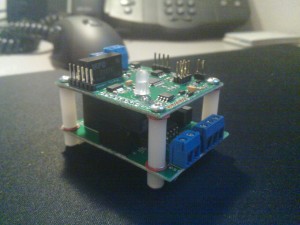I’m going to write the rest of this post in Dutch, since the ISP I’m going to talk about is dutch.
But, for the international visitors: I had troubles getting our brand new Cisco 887VA-SEC-K9 VDSL modem working on a VDSL connection from XS4All (Dutch ISP). It took me about 8 hours in to figure out that ATM was no longer used..
Afgelopen week werd onze ADSL2+ verbinding op kantoor om gezet naar een VDSL verbinding. Vanaf ons kantoor liggen er enkele IPSec tunnels naar een Cisco ASA5510 in het datacenter. Bij de ADSL2+ verbinding hadden we een SpeedTouch ADSL2+ modem in bridge met daar achter een Cisco ASA5505 die de PPP deed.
Bij de upgrade naar VDSL besloten we om net zoals bij de SDSL verbinding die we hebben een Cisco 880 series router te pakken. Lekker makkelijk je modem + router in één en ook direct onder iOS je IPSec tunnels configureren.
Ik kreeg echter onder geen enkele mogelijkheid de Cisco 887VA werkend op de VDSL verbinding. De geleverde Fritz!Box van XS4All werkte prima, maar bij de 887 bleef de interface “ATM0” maar “down”.
XS4All zou de verbinding in de loop van de dag upgraden naar VDSL, dus ik had in de ochtend de Cisco er al tussen geprikt die toen vrolijk ADSL2+ deed. Nadat XS4All in de ochtend de verbinding naar VDSL omzette stopte alles met werken. ATM0 bleef maar down.
Uren gingen voorbij in waarin ik diverse firmwares geprobeerd heb, allerlei ATM settings, DSL modes, noem het maar op, tót ik een blogpost tegen kwam waar iemand aanhaalde dat er geen ATM meer gebruikt wordt bij VDSL, maar het een native Layer 2 verbinding is. Je moet alleen het VLAN nummer weten.
Waar ik het VLAN nummer gevonden heb weet ik niet meer, maar dit is op het KPN netwerk VLAN nummer 6.
Het duurde toen niet lang voordat ik de verbinding werkend had.
De relevante configuratie:
interface Dialer0
ip address negotiated
ip nat outside
ip virtual-reassembly in
encapsulation ppp
dialer pool 1
dialer idle-timeout 0
dialer-group 1
ipv6 address autoconfig default
ipv6 enable
ipv6 nd ra interval 30
ipv6 dhcp client pd xs4all-ipv6 rapid-commit
ipv6 mld query-interval 60
ipv6 virtual-reassembly in
ppp authentication pap callin
ppp pap sent-username USERNAME@xs4all.nl password 0 PASSWORD
no cdp enable
crypto map vpn
!
interface Ethernet0
no ip address
!
interface Ethernet0.6
encapsulation dot1Q 6
pppoe enable group global
pppoe-client dial-pool-number 1
!
interface ATM0
no ip address
shutdown
no atm ilmi-keepalive
!
interface Vlan1
ip address 192.168.X.1 255.255.255.0
ip nat inside
ip virtual-reassembly in
ipv6 address 2001:980:XXXX::1/64
ipv6 enable
ipv6 nd other-config-flag
ipv6 nd ra interval 30
ipv6 dhcp server
ipv6 mld query-interval 60
!
access-list 100 permit ip 192.168.X.0 0.0.0.255 any
ip nat inside source route-map nonat interface Dialer0 overload
ip route 0.0.0.0 0.0.0.0 Dialer0
ipv6 route ::/0 Dialer0
dialer-list 1 protocol ip permit
no cdp run
!
route-map nonat permit 10
match ip address 100
De VDSL verbinding trained op 33Mbit down en 3.4Mbit up, dit zie je op een 887VA in met:
show controllers vDSL 0
Onderaan de output zie je vervolgens:
Firmware Source File Name (version)
-------- ------ -------------------
VDSL embedded VDSL_LINUX_DEV_01212008 (1)
Modem FW Version: 110331_1212-4.02L.03.A2pv6C032b.d23f
Modem PHY Version: A2pv6C032b.d23f
Vender Version:
DS Channel1 DS Channel0 US Channel1 US Channel0
Speed (kbps): 0 33021 0 3432
SRA Previous Speed: 0 0 0 0
Previous Speed: 0 0 0 0
Reed-Solomon EC: 0 79025 0 0
CRC Errors: 0 0 0 0
Header Errors: 0 0 0 0
Interleave (ms): 0.00 12.00 0.00 4.00
Actual INP: 0.00 5.00 0.00 2.00
Met deze configuratie werkt de VDSL verbinding van XS4All prima met zowel IPv4 als IPv6 (Het is 2012!).
Het is belangrijk om te weten dat je de 887VA-SEC-K9 nodig hebt om IPv6 werkend te krijgen! De standaard 887VA-K9 doet GEEN IPv6.
Overigens zou het wel handig zijn als XS4All de basis VDSL configuratie parameters op hun website zet. Ookal leveren ze (logisch!) geen support op andere modems zijn de parameters wel handig om te weten.



